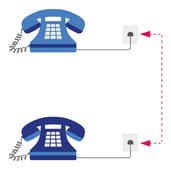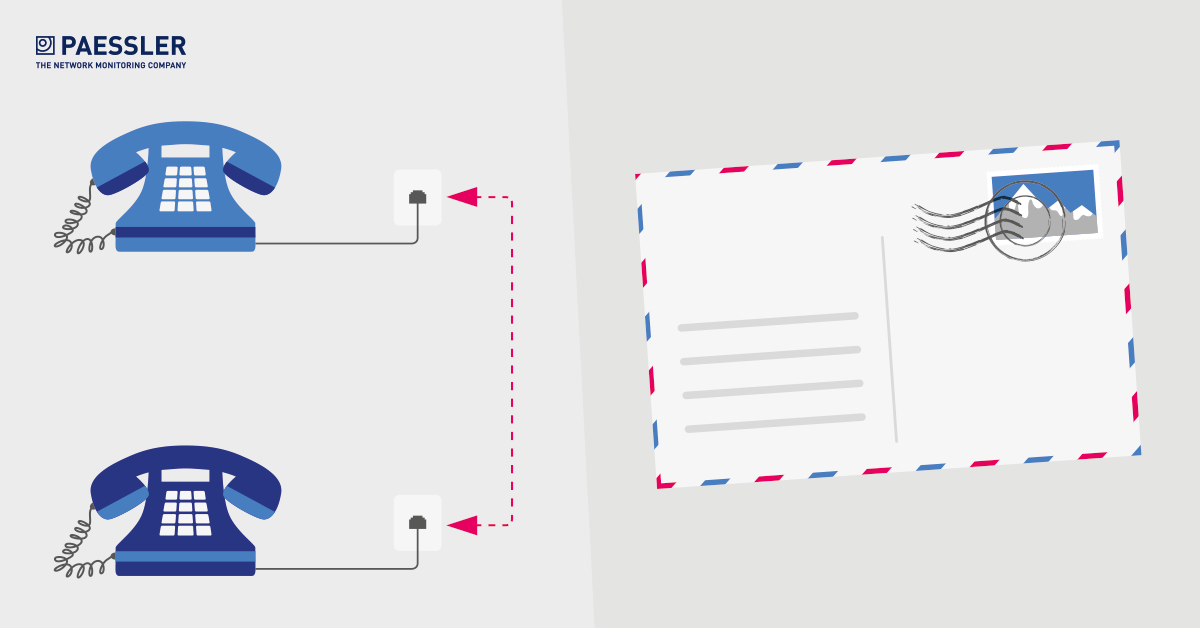QoS (Quality of Service) and QoE (Quality of Experience) performance are among the most important metrics for network monitoring applications that support streaming, like video on demand or VoIP monitoring. End users expect constant and uninterrupted call quality and video playback, and as a systems administrator, it's your responsibility to make sure they receive the QoS they're entitled to by monitoring the right QoS metrics and allocating the proper network resources.
QoS metrics are quantifiable measurements to help you as a network admin monitor, analyze and improve the performance of your network across your infrastructure. Network admins responsible for maintaining consistent voice and video quality have to deal with competing needs of multiple apps and other mission-critical applications. They all demand access to your networks and the available bandwidth and have different sensitivity to latency and jitter. By monitoring the right QoS metrics and optimizing them where possible, you can proactively manage your network and be confident that you've avoided most potential network issues that might affect your end users and breach your service level agreements (SLAs).
You need to carefully plan and operate video and voice-streaming technologies in a highly-complex environment of apps, mobile devices, servers, routers, firewalls, and the underlying network infrastructure. In addition to carefully designing your environment to implement QoS properly, you also need effective network monitoring tools to help you keep a close watch on your QoS metrics and identify bottlenecks in real-time.
But why exactly is it so hard to reliably stream high-quality voice or video over standard LAN and WAN networks? The reason becomes clear when we take a look at the classical telephone network and how it works. Compared to many IP networks that have to deal with different traffic types and applications, the traditional telephone network offers a noticeably better service quality for your voice.
So why don't modern IP networks offer even better QoS and quality than the old-style telephone systems when it comes to time-sensitive data transmission?
Network Architecture Differences Explain Essential QoS Metrics
The answer to this question lies in the basic network architecture and how QoS is implemented. The key difference between them is the telephone network works as a "connection-oriented" resource-reserving system. When you pick up your phone and place a call, the phone system will reserve a fixed end-to-end connection for the entire call duration, guaranteeing that the necessary bandwidth will be allocated for you during the conversation.

IP-based packet data networks, on the other hand, were never designed for low latency or real-time-traffic sensitivity. Instead, they were optimized for maximizing reliability and robustness of data transmission and finding alternative routing paths around failures. The goal of IP was to make sure data packets will eventually make it to their destination – but there were no guarantees for the order they will arrive, the timing, or how fast they will be handled once they are received.
Instead of a single reserved connection, each individual data packet chooses its own way through the network and the overall traffic flow and can therefore take multiple different routes. At the destination, the packets arrive individually and can end up at different destinations in different orders and with different travel times. This is fine for many types of data traffic like emails or web pages, but when it comes to real-time applications like voice or video conferencing and other time-sensitive applications, receiving data packets out-of-order or with inconsistent arrival times creates quality issues.

To be able to reliably and with high-quality stream voice and video over IP networks you need extra mechanisms on top of the basic IP data packets, like traffic shaping and queuing algorithms. While TCP might at first sight sound like a great candidate for VoIP since it's connection-oriented, it turns out that TCP actually prioritizes accuracy over speed. Data packets will all arrive in the correct order, but they can be subject to significant delays along the way creating network jitter and choppy-sounding speech.
UDP does send data packets faster without TCP's overhead and buffer management. While UDP will happily deliver data packets out-of-order or even drop them entirely, for real-time applications, that will actually result in better perceived voice quality than TCP.
So neither TCP nor UDP is ideal for transmitting good quality voice by itself. That's where the QoS settings on your network devices come into play. There are various different techniques for prioritizing your voice traffic over all the other types of traffic using queue management and marking the packets with DSCP (Differentiated Services Code Point).
Important QoS Metrics for Network Performance Monitoring
Latency (delay), jitter, packet loss, throughput/bandwidth usage, and Mean Opinion Score (MOS) are the key network QoS metrics for full assessment of your network quality. These QoS metrics directly affect user experience for all your mission-critical apps:
Latency (Delay)
- Definition: Amount of time it takes for data packets to traverse from source to destination within your network traffic flow
- Acceptable ranges:
- Voice: < 150ms (excellent), 150-300ms (acceptable)
- Video conferencing: < 100ms for real-time sensitive applications
- Data: < 1000ms for most regular apps
- Impact: High latency causes delays in conversations and lagging performance of real-time apps
Jitter
- Definition: Variance in data packets arrival times, measured as delay variation in traffic flow
- Acceptable ranges:
- Voice: < 30ms (excellent), < 75ms (acceptable)
- Video streaming: < 50ms for smooth playback experience
- Impact: Causes choppy audio, pixelated video, buffer underruns, and overall poor user experience
Packet Loss
- Definition: Percentage of data packets that are lost or fail to reach their destination, an indicator for error rate
- Acceptable ranges:
- Voice: < 1% (excellent), < 3% (acceptable)
- Video: < 0.5% for high quality video streaming services
- Data: < 0.1% for critical mission-critical apps
- Impact: Results in missing audio or video segments, video artifacts, and overall low service quality
Throughput vs Bandwidth
- Definition: The actual rate of data transfer compared to available bandwidth capacity and the amount of data that is successfully transmitted
- Measurement: Mbps or Gbps of successfully transmitted data through your network infrastructure
- Impact: Insufficient throughput results in buffering, stuttering playback and quality degradation
Mean Opinion Score (MOS)
- Definition: A subjective scale from 1 (poor quality) to 5 (excellent quality) for measuring user experience
- Acceptable ranges:
- MOS 4.0+ (excellent quality)
- MOS 3.5-4.0 (good quality)
- MOS < 3.0 (poor quality needing immediate optimization)
- Impact: Directly correlates with end-user satisfaction and service level agreements compliance
Advanced QoS Metrics for Comprehensive Network Optimization
In addition to these basic measurements, modern network monitoring also requires additional metrics to fully optimize your network performance:
Packet Delay Variation (PDV): Measures inconsistency in the data packets arrival times, important for time-sensitive real-time applications.
ICPIF (Calculated Planning Impairment Factor): A more advanced voice quality measurement metric that provides a more granular quality score than the basic MOS. It takes into account several impairment factors like delay, echo and network congestion effects.
Application-Specific Quality Metrics: Custom measurement indicators for specific protocols and apps, such as SIP response times and RTP stream quality indicators that can have an impact on the quality of the service.
Network QoS vs Application QoS Metrics and Monitoring
It's also important to understand the difference between Network QoS (NQoS) and Application QoS (AQoS) metrics. While NQoS measures network infrastructure performance, application quality metrics measure end-user experience.
Network QoS (NQoS) measures the performance of the infrastructure supporting network delivery, like router throughput, switch latency, queuing delays and link utilization. NQoS measures the ability of your network to effectively and efficiently deliver these services and are important for enabling QoS through proper traffic shaping and queue management.
Application QoS (AQoS) on the other hand measures end-user experience quality. These metrics cover everything the user interacts with, like call clarity, video resolution, and app responsiveness. AQoS is a good representation for the actual user satisfaction levels with their streaming services, video conferencing and other mission-critical apps.
Monitoring Network QoS with PRTG Sensors
To help you measure all your essential network QoS metrics, PRTG comes with a wide variety of specialized sensors for real-time network quality assessment and traffic flow analysis. The QoS (Quality of Service) Round Trip sensor helps you to monitor your network connection quality between two probes on both ends, measuring all the relevant parameters like latency, jitter, packet loss, response time and overall MOS scores. For one-way unidirectional measurements, the QoS (Quality of Service) One Way sensor provides a detailed analysis of network performance and data transmission from the source to the destination and can help you identify bottlenecks and optimize your data transmissions.
PRTG's QoS sensors even automatically calculate MOS (Mean Opinion Score) values for you, so you instantly get an idea of the voice and video call quality for your users and overall user experience. These QoS sensors support fully configurable packet counts, custom ports, header analysis and even work with remote probes or using the PRTG QoS Reflector tool to allow flexible deployment on different types of network devices. With these sensors you can measure round-trip time (RTT), average/maximum/minimum latency, jitter values, packet delay variation, error rate, and percentage of out-of-order packets, and preconfigured default warning limits for your alerts so you can be proactive about quality issues and potential alerts.
Key Features of PRTG QoS Sensors:
- Real-time monitoring of all essential network QoS metrics across your network infrastructure
- Automatic MOS calculation for voice quality assessment and end-user experience measurement
- Configurable thresholds for proactive alerting based on your defined service level agreements
- Historical trending to help identify performance patterns and further optimize your network resources
- Multi-probe deployment for distributed network monitoring across routers, firewalls and other network devices
- Custom reporting for easily tracking SLA compliance and assessing service quality
Steps for Implementing a QoS Metrics Monitoring Strategy
Use the following steps to implement your own QoS metrics monitoring strategy and get QoS up and running:
-
Identify mission-critical apps that require QoS monitoring (VoIP, video conferencing, streaming services, etc.)
-
Establish baseline measurements for each QoS metric during normal performance periods
-
Configure appropriate warning and critical thresholds based on app requirements and service level agreements
-
Set up monitoring points at strategic network locations (WAN links, data centers, user segments, etc.)
-
Create monitoring dashboards with real-time displays of current QoS metrics, bandwidth usage, network congestion, and historical trending
-
Implement alerting when thresholds are violated so you can quickly respond to quality issues
Monitoring QoS Metrics for Different Types of Applications
Voice over IP (VoIP) Apps
- Primary metrics: Latency, jitter, packet loss, MOS, response time
- Critical thresholds: Latency < 150ms, jitter < 30ms, packet loss < 1%
- Special considerations: Time-sensitive traffic needing priority queuing and resource reservation
Video Conferencing and Streaming Services
- Primary metrics: Throughput, packet loss, jitter, latency, bandwidth usage
- Critical thresholds: Packet loss < 0.5%, jitter < 50ms, consistent throughput
- Special considerations: High bandwidth requirements and DSCP marking for traffic prioritization
Business-Critical Data Apps
- Primary metrics: Throughput, latency, availability, error rate, response time
- Critical thresholds: App specific based on service level agreements
- Special considerations: Queue management and traffic shaping for optimal resource allocation
Troubleshooting Common QoS Problems
High Latency
- Symptoms: High response time, long pauses in VoIP conversations, poor end-user experience
- Solutions: Traffic prioritization via DSCP markings, route optimization, QoS policies
Excessive Jitter
- Symptoms: Choppy audio/video, pixelated video playback, buffer underruns on streaming services
- Solutions: Queue configuration, traffic shaping policies, jitter buffer optimizations
Packet Loss
- Symptoms: Missing audio/video segments, video artifacts, retransmissions impacting overall quality
- Solutions: Capacity planning, implementing redundancies, priority queuing for time-sensitive traffic
Network Congestion
- Symptoms: Reduced throughput, increased latency, poor end-user experience
- Solutions: Bandwidth upgrades, QoS policies, traffic shaping, better queue management
Advanced QoS Techniques and Best Practices
Service providers and network admins use DSCP markings in packet headers to classify different types of traffic. Routers and other network devices can then apply QoS policies to prioritize time-sensitive real-time applications over less important data traffic to ensure the best possible user experience and service quality.
Modern network devices implement various sophisticated queuing algorithms to efficiently manage your traffic flow and optimize network resources. These algorithms can help prevent network congestion and guarantee low latency for critical time-sensitive apps, while still ensuring fair bandwidth allocation for all.
Monitor all critical QoS metrics with PRTG's specialized QoS sensors and make sure you're giving your users the excellent network performance and user experience they deserve. Download the PRTG free trial today and get started with easy-to-use network quality monitoring and full analysis of all your network traffic.
Ready to boost your network's QoS performance and eliminate all bottlenecks? PRTG has all the comprehensive network monitoring tools you need to ensure that your users are enjoying an excellent experience across all your apps, to help you manage network resources efficiently and ensure your service level agreements are being met. Get started today with a free PRTG trial and experience professional-grade QoS monitoring and the impact it can make on your network traffic management.
Want to learn more about network monitoring best practices and implementing QoS? Be sure to check out our comprehensive guides on VoIP monitoring, bandwidth monitoring and network performance optimization.
``` Published by
Published by 












